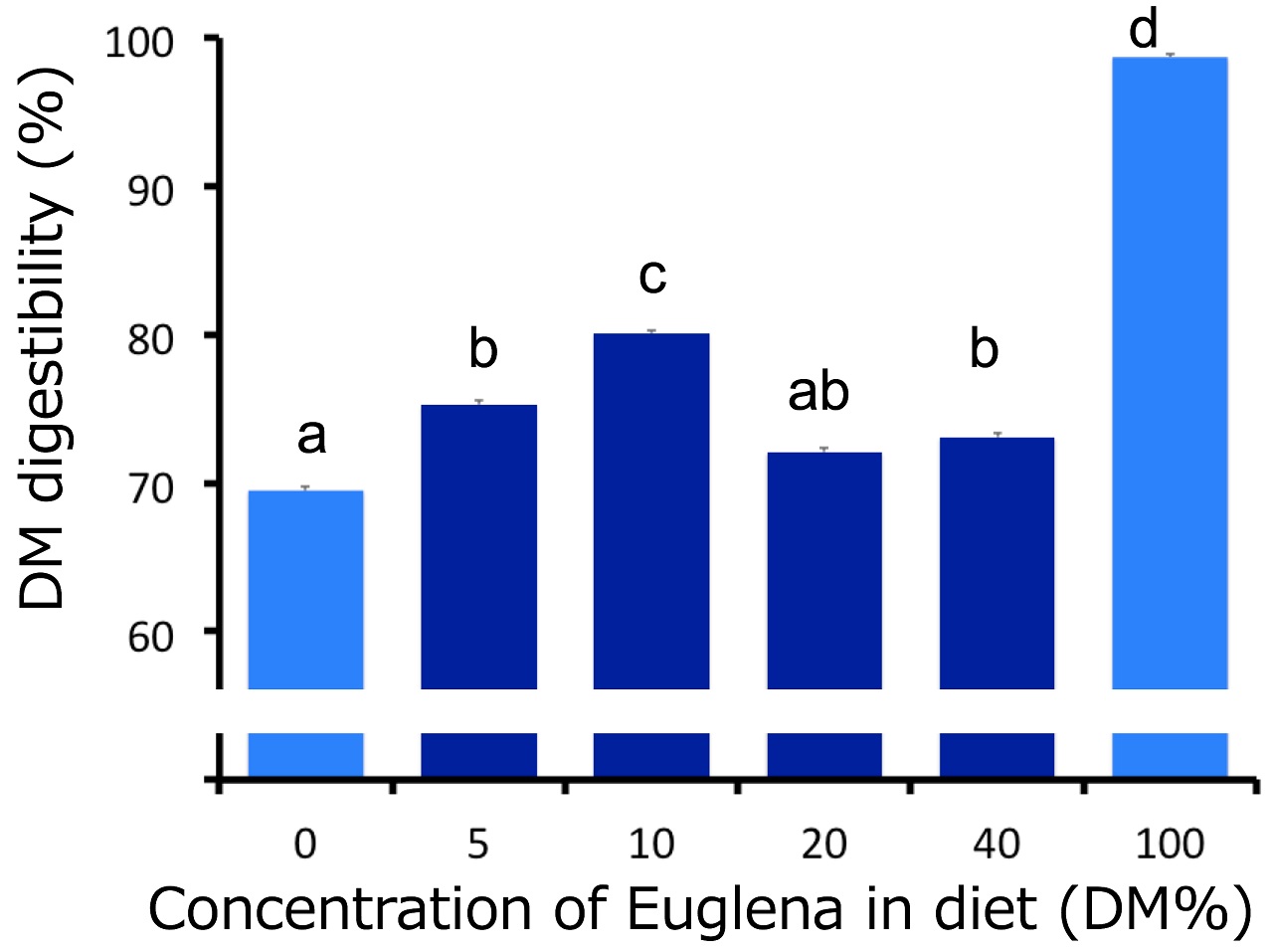NISHIDA Takehiro Professor
ThemeResearch on energy and nitrogen recycle
Study on nutritional control of enteric methane production from ruminant
Study on energy metabolism in livestock animals
Belongs
Research Department/Department of Life and Food Sciences/Division of Animal Production/Section of Animal Husbandry| Field | Animal Nutrition, Sustainable Animal Husbandry, Global Environment Problems |
| Keyword | greenhouse effect gas, global warming, unused feed resources, energy metabolism, feeding standard, Euglena gracilis, insect |
Introduction
Euglenas (e.g., Euglena gracilis) are small microorganisms that are a kind of algae, and their body length is about 0.05 mm. Euglenas have characteristics of both animals and plants. They grow in fresh water, and not only do they store nutrients in their green bodies through photosynthesis like plants do, but they also move by changing the shape of their cell like some animals do. Having both animal and plant characteristics, euglenas provide 59 nutrients, including vitamins, minerals, amino acids and unsaturated fatty acids. In 2005, Euglena Co., Ltd. was the first group in the world to cultivate euglenas en masse outdoors for food.
Euglenas afford several advantages as food. (1) There’s no concern over bovine spongiform encephalopathy (BSE). (2) They have characteristics of plants, so they grow by photosynthesis in fresh water. Tropical regions, which have high-temperature environments, are ideal for their cultivation. (3) The residue that remains after fuel is extracted is promising as a feed resource. (4) Since the extracted fuel mentioned in item (3) can be sold separately, there’s a high possibility that the residue will be inexpensive.
In the rumen of ruminant livestock, methane is generated when feed decomposes by fermentation, and feed is said to lose 2 to 12% of its feed energy when that gas is generated. In addition, since methane has a greenhouse effect approximately 25 times that of carbon dioxide, methane is a contributor to the recent problem of climate change. In other words, suppressing the production of methane in the rumen of ruminant livestock can contribute to improvements in the feed utilization efficiency of ruminant livestock and could mitigate global warming.
We performed culture texts to examine the relationship between the amount of euglena supplied and the amount of methane emissions suppressed (Fig. 1). Methane production began to be suppressed at a 5% supply of euglena, and that suppression increased once a 40% supply threshold was reached. In addition, methane production in sheep was found to be significantly lower in rearing areas where sheep were given feed in which euglena replaced 15% of the concentrated dry feed than in areas where euglena were not added to the feed (Fig. 2).
If we can mitigate methane emissions from ruminant livestock by adding euglena to their feed, this will become a new greenhouse gas reduction method that will contribute to the world. The use of euglena feed is expected to spread through Southeast Asia and Africa, since tropical regions with high-temperature environments are ideal for the cultivation of euglena. In the future, we believe that our country can contribute to international cooperation by establishing an experiment plant at an overseas site and putting such a plant to practical use in suppressing methane generated by fuel resources, feed resources and ruminant livestock.


List of current research topics
- Effects of low fat Euglena (Euglena gracilis) supplemented to diet on methane emissions from sheep
- Effects of fat from Euglena (Euglena gracilis) and fumaric acid supplemented to diet on
- methane emissions from sheep
- Effects of lactic acid bacteria supplemented to diet on nutrient utilization in sheep
- Feed value of waste mushroom bed
- Nutritive value of fermented feed by Aspergillus niger
- Feed value of sprouted brown rice
- Feed value of mealworm for ruminant
| Related industries | animal husbandry, environmental science |
| Affiliated academic society | Japanese Society of Animal Science, Hokkaido Society of Livestock and Grassland Science, Japan Society of Animal Nutrition and Metabolism, Japan Society for Rumen Metabolism and Physiology, Society of Beef Cattle Science |
| Academic degree | ph.D. |
| Self introduction |
I'm from Kurashiki, Okayama Prefecture. After going to university in Kyoto, I joined a research institute of the Ministry of Agriculture, Forestry and Fisheries and started living in Tsukuba, Ibaraki Prefecture. Then, I was transferred to Nasushiobara, Tochigi Prefecture, and studied for a year abroad at Cornell University in the U.S.A. I returned to the Japan International Research Center for Agricultural Sciences in Tsukuba and was dispatched to Thailand for three years. I joined Obihiro University of Agriculture and Veterinary Medicine in 2008. I belonged to a swimming club in my school days and mainly practiced breaststroke and water polo. Recently, I've been practicing calisthenics and training on the treadmill at a gym. I like watching rugby, baseball, Japanese two-hour dramas and American detective dramas. I'm coming to an age where I appreciate reading articles and watching TV programs on health. I don't drink, but I do enjoy a good party. |
| Room address | General Research Building 1 |
| Room number | 2-E2206 |
| Mail address | nishtake  obihiro.ac.jp
obihiro.ac.jp |






